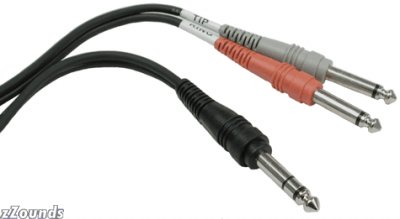spin wrote:I don't understand the setup to make it works through volume. I have to send phatty out to step input and then?
thanks for any help!
Yes. You'll need to:
a) split the signal such that you are sending the audio from your Phatty into the MurF as you do today; and then send 2nd audio cable into the Tap/Step jack. If you don't have mixing equipment or Mults, etc., a simply 'Y' connector will work but best to have a separate volume control or use an attenuator as discussed below on the signal that goes into the Tap/Step jack.
Remember it needs to go across the correct lead of a TRS (tip-ring-sleeve aka Stereo) plug. and then
b) you'll need to adjust the volume of the Tap/Step lead and possibly the waveform/timbre of the sound so that the MurF thinks it's hearing a CV style GATE which is a sharp square pulse that rises quickly in voltage, usually from 0 to 5V or just above then drops quickly.
About the difference between Tap and Step:
Moog designed this jack input to be dual function (this has been written about by myself and others on this forum but to keep you from running around, here it is again...); the first function, "Tap" is a Tap tempo feature and a typical TS (tip sleeve) plug like those used for audio from your LP to a mixing board or amp will work. The MurF uses this to set tempo of the RATE clock by listening for a few steps (I forget if it's 2 or 3). This can be a simple switch or a GATE but a simple switch for this function is what is typically used and most 'sustain' type pedals that you can get at Guitar Center for electric piano's work well. Moog also has the FS-1:
http://www.moogmusic.com/accessories/?s ... t_id=21191
The other function of the input is the Step function which you are interested in and this needs to be wired to the RS (ring sleeve) portion of the TRS (stereo) cable. Once the MurF sees a proper signal across this connector pair, it will stop the RATE clock and not advance the pattern until you Step again.
Cable wise, three ways to do this:
1) use an "Insert" cable which are typically used with midrange to high end mixing boards. They allow an effect like a guitar pedal or rack mounted reverb, etc. (or MoogerFooger) to be placed in-line with the signal through a single cable. It has a Stereo (or TRS) jack on one end and two normal audio TS (mono) on the other; the first of which is wired to TS on the stereo jack and the 2nd which is wired to RS of the stereo jack. There is usually a label on the cable that says "tip" and "ring".
2) buy the Moog Step Adapter which you can find on the accessories page. It's a 2" or so adapter that essentially converts from standard mono to the proper lead on the TRS input. Look here:
http://www.moogmusic.com/accessories/?s ... t_id=21205
3) Make your own cable by cutting off the end of a normal mono cable and soldering a stereo jack (from Radio Shack or wherever).
A few pointers pertaining to the incoming Tap/Step signal:
- once you have the proper cable, you'll want to adjust the volume of the signal going into the Tap/Step jack slowly from low volume until the MuRF reacts to the gate. Definitely start with a very basic sound so that you are sure that the shape of the sound is suitable. Attack 0, Decay 0, Sustain 10, Release 0 for Vol and Filter envelope will do it. The waveform of the actual OSC doesn't matter and shouldn't be confused with the shape of the sound envelope.
- be sure that the signal is not too 'hot' to begin with, don't have the gain up from a mic preamp circuit. You want this to be a line level signal, NOT amplified through a 600 watt bass head : ) else, damage to your MuRF will result.
Once you have the basics working, tweak the Phatty sound to suit your needs or pick a patch that you like; you may find that it is not appropriate to cause the MurF to step (Envelope too smooth or timbre too soft, etc.)
Hope this further explanation helps.

